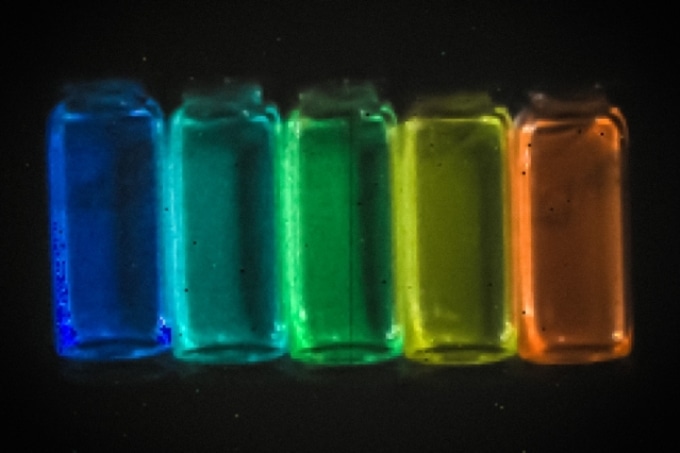Apr 11 2017
 Researchers have found a way to make tiny particles that can be injected into the body, where they emit short-wave infrared light. The advance may open up a new way of making detailed images of internal body structures such as fine networks of blood vessels. (Image: Bawendi Group at MIT)
Researchers have found a way to make tiny particles that can be injected into the body, where they emit short-wave infrared light. The advance may open up a new way of making detailed images of internal body structures such as fine networks of blood vessels. (Image: Bawendi Group at MIT)
A majority of biological tissues are virtually as transparent as glass when exposed to certain frequencies of short-wave infrared light. Recently, researchers have created minute particles that can be injected into the body, where they release those penetrating frequencies. This progress may lead to a new way of creating comprehensive images of internal body structures such as fine networks of blood vessels.
The new findings have been reported in the journal Nature Biomedical Engineering, by MIT research scientist Oliver Bruns, recent graduate Thomas Bischof PhD ’15, professor of chemistry Moungi Bawendi, and 21 others. The research paper describes the use of light-emitting particles called quantum dots.
Near-infrared imaging, with wavelengths between 700 and 900 nm (billionths of a meter), is extensively used for research on biological tissues, but wavelengths of about 1,000 to 2,000 nm possess the potential to offer much better results, as body tissues are more transparent to that light. “We knew that this imaging mode would be better” than existing techniques, Bruns explains, “but we were lacking high-quality emitters” — that is, light-emitting materials that could create these precise wavelengths.
Light-emitting particles are a specialty of Bawendi, the Lester Wolf Professor of Chemistry, whose lab has been involved for years in the development of new methods of creating quantum dots. These nanocrystals, composed of semiconductor materials, discharge light whose frequency can be precisely adjusted by controlling the exact composition and size of the particles.
The strategy was to create versions of these quantum dots whose emissions corresponded with the preferred short-wave infrared frequencies and were sufficiently bright to then be easily detected through the surrounding muscle tissues and skin. The team had succeeded in creating particles that are “orders of magnitude better than previous materials, and that allow unprecedented detail in biological imaging,” Bruns says. The synthesis of these new particles was originally illustrated in a paper by graduate student Daniel Franke and others from the Bawendi group in Nature Communications last year.
The quantum dots, which the team created, are very bright allowing their emissions to be captured with very short exposure times, he says. This facilitates the development of not only single images but video that captures motion details, such as the flow of blood, making it possible to differentiate between arteries and veins.
Furthermore, the new light-emitting particles are the first of its kind that are sufficiently bright to allow imaging of internal organs in mice that are awake and moving, as opposed to earlier techniques that required them to be anesthetized, Bruns says. Preliminary applications would be for preclinical research in animals, as the compounds have certain materials that may not be approved for use in humans. The MIT team is also involved in developing versions that would be safer for humans.
The technique also depends upon the use of a recently developed camera that is highly sensitive to this specific range of short-wave infrared light. Bruns explains that the camera is a commercially developed product, and that his team was the first to use the camera’s specialized detector, made of indium-gallium-arsenide. Although this camera was built for research purposes, these infrared light frequencies can also be used to see through smoke or fog.
The new technique not only defines the direction of blood flow, but also is comprehensive enough to monitor individual blood cells within that flow. We can track the flow in each and every capillary, at super high speed. We can get a quantitative measure of flow, and we can do such flow measurements at very high resolution, over large areas.
Oliver Bruns, Research Scientist, MIT
Such imaging could possibly be used, for instance, to examine how the blood flow pattern in a tumor changes as the tumor progresses, which might result in novel ways of monitoring responsiveness to a drug treatment or disease progression. “This could give a good indication of how treatments are working that was not possible before,” he says.
This is an exciting and potentially revolutionary development for small animal imaging. By using probes that are tuned to wavelengths further out in the short-wave near-infrared, the investigators overcome scattering, which is the major phenomenon limiting such in vivo microscopy. In so doing, simpler and less invasive interrogation methods can be utilized to understand structure and function in animal models, on both the organ and cellular level. I anticipate that these probes will have a major impact on the field of intravital [done with living subjects] imaging and bioscience research.
Guillermo Tearney, Professor of Pathology at Harvard Medical School
The team included members from MIT’s departments of Chemistry, Chemical Engineering, Biological Engineering, and Mechanical Engineering, as well as from Harvard Medical School, the Harvard T.H. Chan School of Public Health, Raytheon Vision Systems, and University Medical Center in Hamburg, Germany. The work was supported by the National Institutes of Health, the National Cancer Institute, the National Foundation for Cancer Research, the Warshaw Institute for Pancreatic Cancer Research, the Massachusetts General Hospital Executive Committee on Research, the Army Research Office through the Institute for Soldier Nanotechnologies at MIT, the U.S. Department of Defense, and the National Science Foundation.